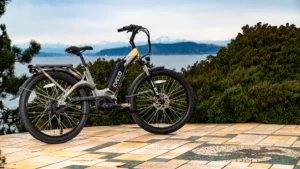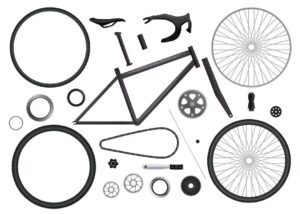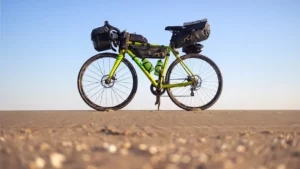Guiador de bicicleta, como uma parte importante das peças da bicicleta, desempenham um papel crucial na funcionalidade geral e no conforto da sua experiência de ciclismo. Neste guia abrangente, vamos mergulhar 8 diferentes tipos de guiador para bicicletas disponível. Quer você seja um ciclista de estrada em busca de velocidade, um mountain bike em busca de aventura, ou um piloto de lazer em busca de conforto, existe um tipo de guidão de bicicleta projetado especialmente para você.
8 Tipos de guiador de bicicleta
Há 8 tipos comuns de guidões disponíveis para bicicletas, incluindo:
- Barras suspensas: Ideal para ciclismo de estrada, essas barras oferecem posicionamento aerodinâmico, transferência de energia, e controle.
- Barras planas: Adequado para mountain bike e passeios de lazer, eles fornecem uma posição de pilotagem vertical para manobrabilidade.
- Barras de elevação: Projetado para passeios off-road e trilhas, essas barras oferecem uma postura mais confortável e ereta.
- Barras de megafone: Popular no ciclismo urbano, eles têm um design elegante e posições de aderência versáteis.
- Aerobares: Projetado especificamente para contra-relógio e triatlos, essas barras aumentam a velocidade e a eficiência com uma posição aerodinâmica.
- Barras de borboleta: Adequado para passeios e passeios de longa distância, eles oferecem várias posições de mão para maior conforto.
- Barras de bigode: Essas barras oferecem versatilidade com uma ampla variedade de posições de mão e são adequadas para vários estilos de pilotagem.
- Barras Cruzadoras: Perfeito para passeios casuais e de lazer, eles oferecem uma posição de pilotagem relaxada e confortável.
Barras suspensas

Barras suspensas são uma escolha clássica para entusiastas do ciclismo de estrada. Com um design curvo que promove uma postura aerodinâmica, barras suspensas oferecem inúmeros benefícios. Estes incluem melhor transferência de energia, aumento de velocidade, e controle aprimorado. Desde barras suspensas tradicionais até variações compactas e ergonômicas, existe um tipo de guiador que se adapta às preferências de cada condutor.
Barras planas

Ideal para mountain bike e passeios de lazer, barras planas oferecem uma posição de pilotagem mais ereta, garantindo melhor controle e manobrabilidade em terrenos acidentados. A simplicidade do seu design torna-os altamente versáteis e adequados para pilotos de todos os níveis de habilidade. Explore variações como barras planas riser ou barras planas largas para encontrar o estilo ideal.
Barras de elevação

Se andar off-road e em trilhas é sua paixão, barras verticais são a escolha perfeita. Esses guidões apresentam uma elevação mais alta, proporcionando uma postura de pilotagem mais ereta e confortável. As barras riser são excelentes na absorção de choques e vibrações, garantindo um passeio suave e agradável em terrenos desafiadores. Diferentes variações, incluindo barras elevatórias retráteis, permitir maior personalização para alcançar a posição de pilotagem desejada.
Barras de megafone

Popular entre ciclistas urbanos e urbanos, barras de megafone oferecem um design elegante e moderno. Com seu formato único que lembra megafones, esses guidões oferecem múltiplas posições de aderência, atendendo a diferentes preferências de pilotagem. Se você prefere uma posição avançada para um passeio mais agressivo ou uma pegada relaxada para um ciclismo casual, barras de megafone oferecem versatilidade e uma estética moderna.
Aerobares

Projetado para contra-relógio e triatlos, barras aerodinâmicas permitem que os ciclistas obtenham um posicionamento aerodinâmico, minimizando o arrasto e maximizando a velocidade. Esses tipos de guiador apresentam apoios de braços estendidos que proporcionam estabilidade e suporte durante esforços intensos. Para ciclistas competitivos que perseguem cada segundo do relógio, as barras aerodinâmicas são uma virada de jogo quando se trata de reduzir a resistência ao vento e aumentar a eficiência.
Barras de borboleta

Para passeios e passeios de longa distância, barras de borboleta são uma escolha popular, então . Seu design exclusivo oferece múltiplas posições de mão, permitindo que os ciclistas combatam a fadiga e mantenham o conforto durante longas horas na estrada. Com uma variedade de opções emocionantes, incluindo tops, capuzes, e gotas, barras borboleta oferecem aos ciclistas versatilidade incomparável para viagens otimizadas de longa distância.
Barras de bigode

As barras de bigode oferecem uma aparência distinta e uma ampla variedade de posições de mãos. Com uma curva ampla que lembra um bigode, estes guiadores proporcionam uma experiência de condução confortável e ergonómica. Barras de bigode são adequadas para ciclistas que buscam versatilidade, pois acomodam vários punhos, tornando-os adequados para passeios de lazer ou passeios de longa distância.
Barras Cruzadoras

Se você preferir uma posição de pilotagem relaxada e confortável, barras cruiser são a combinação perfeita. Este guiador largo e curvo promove uma postura ereta, tornando-os ideais para passeios casuais e de lazer. Barras Cruiser melhoram a estabilidade, controlar, e conforto geral, permitindo que você mergulhe na paisagem e desfrute de uma experiência descontraída de ciclismo.
Fatores a serem considerados ao escolher o guiador
Quando se trata de escolher o guiador certo para a sua bicicleta, vários fatores importantes devem ser considerados.
Conforto e Ergonomia
Em primeiro lugar, priorize seu conforto enquanto anda. O guiador deve proporcionar uma aderência confortável e minimizar a tensão nos pulsos, mãos, e parte superior do corpo. Considerar guiador com design ergonômico, como aqueles com formas contornadas ou alças acolchoadas, para aumentar o conforto durante passeios longos.
Ajuste e compatibilidade da bicicleta
Certifique-se de que o guidão que você escolher esteja compatível com as especificações da sua bicicleta. Fatores como diâmetro do caule, tamanho da braçadeira, e a largura do guiador devem estar alinhadas com o quadro e o garfo da sua bicicleta. Um ajuste adequado da bicicleta otimizará sua postura de pilotagem, reduzir o risco de lesões, e melhorar o desempenho geral. Se você não tiver certeza sobre a compatibilidade, consulte um montador de bicicletas profissional ou consulte as orientações do fabricante.
Estilo de pilotagem e terreno
O guidão que você selecionar deve estar alinhado com seu estilo de pilotagem específico e o terreno que você normalmente encontra. Por exemplo, se você dirige principalmente em estradas e busca velocidade, barras suspensas aerodinâmicas são a escolha ideal. Por outro lado, se você costuma enfrentar trilhas off-road, considere guidões com punhos mais largos e posições mais verticais para melhor controle e estabilidade. Combinar o guidão com seu estilo de pilotagem e terreno melhorará sua experiência geral de pilotagem.
Preferência e experiência pessoal
A escolha do guiador pode ser uma questão de preferência pessoal. Fatores como o tipo de punho do guiador, o formato da barra, e a estética geral pode variar de piloto para piloto. É importante considerar suas próprias preferências e se você tem alguma necessidade ou limitação específica. Adicionalmente, leve em consideração o seu nível de experiência como ciclista. Os iniciantes podem preferir guidão que ofereça mais estabilidade e facilidade de uso, enquanto os pilotos experientes podem optar por guidões mais especializados que atendam ao seu estilo específico.
Escolha uma loja ou fabricante local confiável
Para garantir o mais alto nível de qualidade e desempenho, é aconselhável compre guidões em uma loja de bicicletas local confiável ou de boa reputação fabricante de peças para bicicletas. Esses estabelecimentos contam com funcionários experientes que podem fornecer orientação com base em suas necessidades específicas e ajudá-lo a tomar uma decisão informada.. Eles também podem oferecer suporte para instalação e ajustes adequados, garantindo que seu guidão esteja configurado corretamente para desempenho e segurança ideais.
Como testar o guiador?

Para encontrar o tipo de guiador perfeito, é essencial testá-los. Visite uma loja de bicicletas local que oferece a oportunidade de experimentar diferentes guiadores através de testes. Se possível, considere alugar ou pedir emprestado vários tipos de guiador para aproveitar plenamente seus benefícios. Adicionalmente, busque conselhos de ciclistas experientes ou comunidades on-line para obter insights e recomendações.
Conclusão
Para concluir, o guiador da bicicleta é mais do que apenas um componente funcional. Eles desempenham um papel vital na determinação do seu conforto, controlar, e estilo de pilotagem. Ao compreender as características e benefícios dos diferentes tipos de guiador, você pode tomar uma decisão informada que aprimore suas aventuras de ciclismo. Lembrar, o guidão perfeito é aquele que atende às suas necessidades e preferências individuais, garantindo diversão sem fim em sua bicicleta.
Perguntas frequentes sobre guidões de bicicleta
- Os guidões de bicicleta são universais?
Não, guidão de bicicleta não é universal. Eles vêm em diferentes formas, tamanhos, e estilos para atender a diversas disciplinas e preferências de pilotagem. É importante escolher guiadores que sejam compatíveis com as especificações da sua bicicleta e com o seu estilo de pilotagem.
- Como remover os punhos do guiador?
Para remover os punhos do guiador, você pode seguir estes passos:
um. Comece afrouxando a aderência borrifando uma pequena quantidade de álcool isopropílico ou água com sabão por baixo dela.
b. Use uma chave de fenda ou ferramenta semelhante para retirar cuidadosamente o punho do guidão. Trabalhe lentamente ao redor da empunhadura até que ela se solte.
c. Uma vez que o aperto está solto, você pode deslizá-lo para fora do guidão.
- Por que as mountain bikes têm guidões largos?
As mountain bikes possuem guidões largos para proporcionar maior estabilidade, controlar, e alavancagem ao andar em terrenos acidentados e técnicos. Guiador largo oferece melhor manuseio e manobrabilidade, permitindo que os pilotos tenham melhor controle sobre sua bicicleta ao navegar por obstáculos e trilhas desafiadoras.

















